This document provides an overview of various radiological equipment and imaging modalities used in medical diagnosis. It discusses x-ray equipment, computed tomography (CT), ultrasound, magnetic resonance imaging (MRI), nuclear medicine, and radiation therapy. For each modality, it describes the basic principles, imaging techniques, clinical applications, and technological advances. The document is intended as an introductory lecture on radiological equipment for medical students.



























